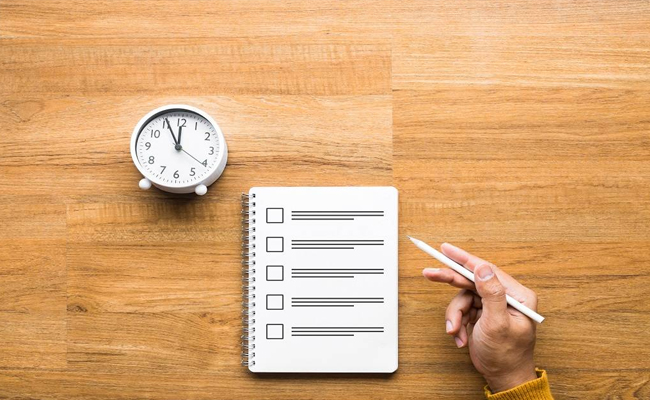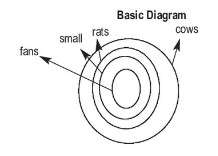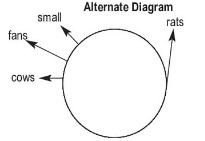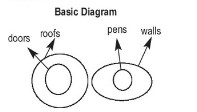Model Questions for Reasoning in Bank Prelims Exams

MODEL QUESTIONS:
Following topics are some of the areas which are expected in the forthcoming SBI POs prelims examination.
1. SYLLOGISMS
2. SEATING ARRANGEMENT
3. PUZZLE TEST
Let us see some examples with solutions:
SYLLOGISMS
1. Statements:
All balls are round.
Some round are plates.
All plates are utensils.
Conclusions:
I. Some utensils being balls is a possibility.
II. Some plates being balls is a possibility.
Solution:

Both the possible conclusions follow as an alternate diagram can be drawn.
SHORT CUT: If all the given statements are affirmative (positive), then every positive possible conclusion is VALID on the given terms. Hence, both the conclusions follow.
2. Statements:
All fans are small.
All small are rats.
All rats are cows.
Conclusions:
I. Some cows are not small.
II. Some cows are not fans.
Solution:


As all the given statements are affirmative, there is a possibility of 'All cows are small' as well as "All cows are fans". Hence, both the conclusions do not follow.
SHORT CUT: If the given statements are positive then every negative definite conclusion is NOT VALID.
16,000 Jobs: Mega Job Mela in Hyderabad... Check Date and Venue!
3. Statements:
No wall is roof.
All pens are walls.
All doors are roofs.
Conclusions:
I. No any door is wall.
II. No any roof is pen.
Solution:

No any door is wall' means 'No door is wall'. Similarly, 'No any roof is pen' means 'No roof is pen'. Clearly, both the conclusions are valid as alternate diagram cannot be drawn.
SEATING ARRANGEMENT
A. Study the following information carefully and answer the questions:
A, B, C, D, E, F and G are sitting in straight line facing North.
B sits fourth to the left of A who is second to the left of C. D, who is not an immediate neighbor of A, sits to the immediate right of E. F sits second to the left of G.
4. Which of the following pairs sit at the extreme corners of the line?
1) BC 2) EC 3) BG 4) ED 5) None of these
5. How many persons sit between D and G?
1) One 2) Two 3) Three 4) None 5) None of these
6. Four of the following five are alike in a certain way based on their seating positions in the above arrangement and so form a group. Which is the one that does not belong to that group?
1) BD 2) EF 3) AC
4) AD 5) FG
Solution: While solving seating arrangement questions we have to first of all focus on the definite information given. Step wise explanation is given below.
Step1: B sits fourth to the left of A who is second to the left of C.
B A C
_ _ _ _ _ _ _
Step2: D is not an immediate neighbour of A and D sits to the immediate right of E.
B E D A C
_ _ _ _ _ _ _
Step3: Now, the process can be completed in the following way
B E D F A G C
_ _ _ _ _ _ _
Answers: 4) 1 5) 2 6) 4
Explanation: In every option first person is second to the left of second person where as in the fourth option, first person is second to the right of second person (A is second to the right of D)
29th August 2024 Current Affairs
B. Study the following information carefully and answer the following questions:
There are eight friends A, B, C, D, E, F, G and H are seated in a circle facing the centre but not necessarily in the same order.
D is as far away from A as C is away from E.
AC, DG, HE and FB are seated adjacent to each other. A is also seated adjacent to H. B is second to the right of H and E is third to the right of C.
7. Who is second to the left of A?
1) B 2) E 3) G 4) D 5) None of these
8. If B and G interchange their places, who sits to the immediate right of E?
1) B 2) C 3) G 4) D 5) None of these
9. If all the persons are made to sit in alphabetical order starting from A in clockwise manner, the positions of how many will remain unchanged, other than A, as compared to the original seating positions
1) One 2) Two 3) Three
4) Four 5) None of these
Solution:
Firstly, focus on the definite information.
1. B is second to the right of H.
2. A is adjacent to H as well as C.
3. E is third to the right of C.
As C is third to the left of E, D must be third to the left of A. So, the arrangement can be properly constructed in the following way.

Answers:
7) 3 8) 3 9) 2
Explanation: 'D' and 'H' positions remain unchanged
SCILAL Latest Executives Posts Notification 2024| Starting Salary Rs.70,000/-
PUZZLE TEST
Study the following information carefully and answer the following questions:
A, B, C, D, E and F are six persons in an organization who are of different heights. Each one has different colour of pens - black, white, blue, green, red and yellow.
The tallest person does not like blue or white.
The youngest person does not like black or red.
'C' likes yellow and only one person is taller than him.
'A' likes white colour and is taller than E but shorter than F. B likes black and is shorter than A but taller than E. D likes blue and E likes red.
10. How many persons are taller than D?
1) One 2) Two 3) Three
4) Four 5) None of these
11. The tallest among them prefers the pen of
1) Red colour 2) Green colour
3) White colour
4) Cannot be determined
5) None of these
12. Who is taller than only the shortest?
1) B 2) E 3) D
4) A 5) None of these
Solution: Let us focus on the definite points first
1. Only one person is taller than C. So, C is 2nd tallest.
2. A is taller than E but shorter than F ® F > A > E.
3. B is shorter than A but taller than E. ® A > B > E
| PERSON | COLOUR OF PEN | HEIGHT |
| A | WHITE | 3rd tallest |
| B | BLACK | 4th tallest |
| C | YELLOW | 2ndtallest |
| D | BLUE | Shortest |
| E | RED | 5th tallest |
| F | GREEN | Tallest |
4. Considering 2 & 3
® F > A > B > E
5. By considering 1 & 4
® F > C > A > B > E
Order of heights:
F > C > A > B > E > D
Answers:
10) 5 (Total 5 persons are taller than D)
11) 2
12) 2 (Taller than only the shortest means 'the person who is 2nd shortest. i.e. E')
500 Vacancies| Union Bank of India Latest Apprentice Recruitment 2024




















